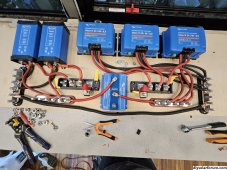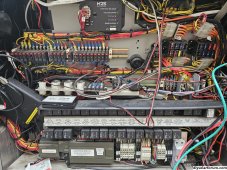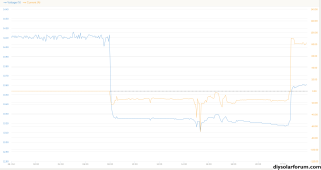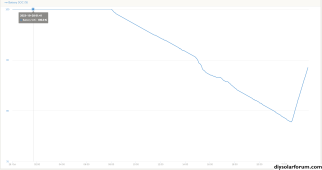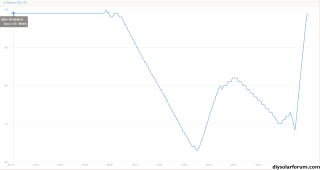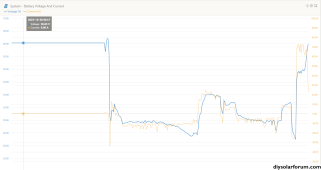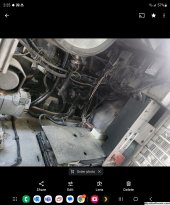justinm001
Solar Addict
- Joined
- Dec 18, 2022
- Messages
- 1,534
I have a 50DN industrial alternator designed to pump out 270a 24V continuously and is oil cooled. Currently disconnected but plan on connecting to my 24V chassis alternator (70a) and 24V starter battery system (4 12v batteries in series/parallel. This connects using a 2/0 gauge wire running 40ft from the rear of the DP engine to the front under bumper. The large alternator will be controlled with a wakespeed WS500 and will derate power if temps get high.
On top of this I have a 12V 10kwh battery bank for dc loads and aux house inverter as well as a 48v 10kwh battery bank powering the main inverter loads. I'm planning 9 total DC to DC converters since there doesn't seem to be anything larger. Since testing shows my alternators power shuts off when the engine is turned off I plan on using the remote disconnect connectors to 2 3 position switches, One All/Half/Off and other both/12v/48v. This would give me 9 options while driving incase i notice any decline in power and since I could be pulling over 4500w it could be taking 7HP from the engine, even though I have a massive engine it might affect going uphill. Also these chargers seem to put out a lot of heat so 8 might be a bit extreme. With the 2/0 existing wire I'll be right the 195a limit at 90c.
3x Victron Energy Orion 24/12-Volt 70 amp DC-DC Converter (2500w total 105a 24v 210a 12V)
5x Victron Energy Orion-Tr IP43 24/48-Volt 8.5 amp 400-Watt Isolated DC-DC Converter (2000w total 43a 48v and 85a 24V)
My question is what buss bar should I use for all of these? Ideally a lynx distributor but thats only 4 ports (5 or 6 if you use blue sea) and seems a bit of a waste to get 2 of them. I'd want fuses or breakers for all 8 plus something for the incoming power.
I was surprised how hot the 24/48v got when testing the 1 I have now. Would plywood be good enough for a base or should I consider some form of metal to act as a heatsink? My front bumper folds down and I have about a 2ftx6ft stainless steel floor space and about 2ft of height. Behind that is my 12V batteries and Quattro5000. The goal is to build it all on something removable so if I need to work on the 12v system I can just unscrew the board and remove the main wires to the buss bars and pull it out.
Should I set them all to the same voltage and what voltage should they be at?
On top of this I have a 12V 10kwh battery bank for dc loads and aux house inverter as well as a 48v 10kwh battery bank powering the main inverter loads. I'm planning 9 total DC to DC converters since there doesn't seem to be anything larger. Since testing shows my alternators power shuts off when the engine is turned off I plan on using the remote disconnect connectors to 2 3 position switches, One All/Half/Off and other both/12v/48v. This would give me 9 options while driving incase i notice any decline in power and since I could be pulling over 4500w it could be taking 7HP from the engine, even though I have a massive engine it might affect going uphill. Also these chargers seem to put out a lot of heat so 8 might be a bit extreme. With the 2/0 existing wire I'll be right the 195a limit at 90c.
3x Victron Energy Orion 24/12-Volt 70 amp DC-DC Converter (2500w total 105a 24v 210a 12V)
5x Victron Energy Orion-Tr IP43 24/48-Volt 8.5 amp 400-Watt Isolated DC-DC Converter (2000w total 43a 48v and 85a 24V)
My question is what buss bar should I use for all of these? Ideally a lynx distributor but thats only 4 ports (5 or 6 if you use blue sea) and seems a bit of a waste to get 2 of them. I'd want fuses or breakers for all 8 plus something for the incoming power.
I was surprised how hot the 24/48v got when testing the 1 I have now. Would plywood be good enough for a base or should I consider some form of metal to act as a heatsink? My front bumper folds down and I have about a 2ftx6ft stainless steel floor space and about 2ft of height. Behind that is my 12V batteries and Quattro5000. The goal is to build it all on something removable so if I need to work on the 12v system I can just unscrew the board and remove the main wires to the buss bars and pull it out.
Should I set them all to the same voltage and what voltage should they be at?



